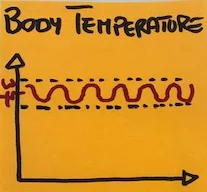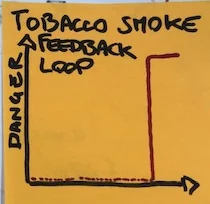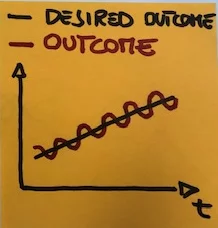What can Product Development learn from our body temperature regulating system?
Systems are all around us, and inside us. Understanding the systems we live and work in is fundamental if we want to navigate the problems that they carry.
Let’s think about our body as a system. It is a pretty complex and advanced one as it went through millions of years of evolution to get to the current state. Its working is truly fascinating and even though we have been studying it for millennia, there are parts that we still don’t fully understand.
Our body, as all systems, contains feedback loops. One we are very familiar with, is our body temperature regulating system. In order for our body to work well, its temperature needs to be between 36.5 and 37.5 degrees Celsius. In extreme circumstances, if it goes under 25 degrees we can die and a rising body temperature can damage our organs very quickly.
How do we make sure that this doesn’t happen without a thermometer that measures our temperature constantly?
Our body has a very sophisticated yet simple feedback loop system that allows us to regulate the temperature to the optimal range. In fact if we go out naked in the snow, we immediately feel a cold sensation, decide to get back into the house to put on some heavy clothes and then go out again. If we are running or exercising for a prolonged period of time and our temperature raises, our system will automatically start sweating to reduce and regulate it to its optimal range.

What happens every day of our life is that our body temperature will oscillate within a range of acceptable temperatures because, through evolution, it has designed a defence system based on fast feedback loops. By continuously knowing when it’s too hot or too cold we are guaranteed we won’t die frozen or for too much heat. A slower feedback might have caused our body to freeze, imagine for example if we felt the cold only after 24 hours in the snow, but a feedback loop fast enough prevents all that.
What a great system our body is. But even such a wonderfully evolved system has its Achilles heel, in fact it can be damaged by slow feedback loops.
Let’s think for example about the effects of smoking tobacco on our body. How come we only recently found out that smoking is so dangerous for our body? Why did it take so long?
When we smoke our first cigarette, chemicals such as tar and formaldehyde penetrate the cells in the lung tissue and change them. At first our body may be able to repair the damage. With repeated exposure, normal cells that line our lungs are increasingly damaged. Over time, the damage causes cells to act abnormally and eventually cancer may develop.
The problem is in the fact that the time that will take for the cancer to develop is so long that only recently we could only start hypothesising tobacco smoke was a potential cause. You can easily imagine why. In ~30 years our body absorbs an incredible amount of chemicals coming from all sources, the food we eat, the air we breathe and the tobacco smoke we inhale. How could we have guessed? It was very difficult and only through data driven medical studies we managed to identify a clear link between tobacco smoke and cancer.

Tobacco smoking is a very recent habit in human history if we consider humans evolution and our body has not yet developed a defence from it. What happens unfortunately is that our body will alert us of the cancer (feedback loop) only when it has damaged one of our organs. At that point, unfortunately, it is often too late to repair the damage.
A slow feedback loop can often look like the this picture. No impact for a long period of time, then a massive impact all of a sudden.
Slow feedback loops are everywhere around us, look at how some policies that seemed harmless at first sight, have caused migrations, desertification and destruction, years after, look at how the excess co2 in the atmosphere is damaging our planet slowly but nevertheless unequivocally.
Not being able to predict the effects of policies and changes to a system is troubling, but how does this fit with modern organisations and product development?
The link is in the feedback loops. We have seen earlier how the fast feedback built in our body temperature regulating system has helped our body defend itself from changes in temperature for millions of years, can we learn something from it?
A system that oscillates within a healthy range, like our body temperature, is a balanced and healthy system. What produces the healthy oscillation is the speed at which the feedback is delivered. Our body senses the changes in temperature very quickly and allows for regulating it in a way that appears to us to be continuous.
Now let’s think about organisations that rather than regulate their own temperature are trying to achieve an outcome.
Let’s look at product development for example.
Traditional organisations spend quite a lot of time studying the market to identify new solutions or products that can help them achieve an outcome. This work is often done by internal experts. Such experts have been involved in delivering previous products and are naively expected to have the wisdom that is required to design the product that will achieve the goal.
A lot of work happens inside the organisation and a lot of time passes before the new product is given to the customers. The more time the idea stays within the organisation the more we build assumptions upon assumptions instead of satisfying real customer needs. After one year or two we finally have a new product on the market, but very often we realise that the outcome we had originally thought we would get is not materialising. We often are very far from the expected outcome. We are objectively surprised, sometimes astonished at the results.
Our plan didn’t survive contact with reality.
Reality indeed, this is the first time we get feedback from our customers and it’s not what we thought it would be.

Organisations rarely understand the cause of the problem and often an unsuccessful product causes blame games. Everybody is to blame, excluding the people that designed the product. “The market has changed!”, “The latest regulatory policy makes it more difficult to use!”, “The downturn of the economy killed us!” Et cetera. I even heard leaders blame the customers, saying things like “they don’t understand!”
Slow feedback loops for product development cause something like this picture. The delta can be very big in the presence of slow feedback loops.
What can we do to avoid the truly sobering experience of showing our customers the fruit of years of our work and seeing it rejected? Well, we can’t avoid it completely but we can make it much less painful if we introduce a balancing feedback loop like the one

that regulates our body temperature.
The first thing to do is to identify an outcome we want to reach over time. This outcome is for us now the ideal body temperature we want to maintain.
The second thing we need to do is to plan regular and frequent feedback loops with our customer to verify directly in the real world how we are doing against the outcome.
The third thing is to measure how we are doing against the outcome and design the next bit of functionality taking in consideration the learning from the last feedback loop.
A fast feedback loop on product development causes a behaviour like the one in the picture.
By doing this we make sure not to diverge too much from our desired outcome. We know that we will make bad decisions that might move us further away from reaching it, but we also know that through frequent feedback loops we will be able to discover our mistakes early and take actions to repair them in a cost effective way.
It looks like we can learn a lot from our body temperature regulating system and treat our customers like our body regulates our temperature, with care and continuously.
Published on Java Code Geeks with permission by Augusto Evangelisti, partner at our JCG program. See the original article here: What can Product Development learn from our body temperature regulating system? Opinions expressed by Java Code Geeks contributors are their own. |


